Here we are going to go into details on the thermal testing as well as flow rate testing as part of the 290 GPU block roundup. Let’s start with flow rates because it’s quicker!
Flow Rate Testing
If you don’t know what a pressure/flow plot is or what it means and how to read it see this guide.
So essentially we see one very noticable thing – the Alphacool block is *extremely* restrictive and far more so than any other block. The other blocks are all relatively close to our point of reference – the Koolance CPU-380 cpu waterblock that is of average to high restriction.
All the other blocks would be considered acceptable, with the Bitspower and Swiftech being considered very high flow. A block being high flow aka low restriction is a good thing however it is not everything, realistically given acceptable flow, the thermal performance is generally a greater concern.
Thermal Testing
Thermal testing was done in a way to mimic “worst case”. In reality you are unlikely to see temperatures as bad as this when gaming even when overclocked and over volted.
Bench setup:
R9-290 @ 1150MHz +100mV (203MHz overclock), 1375MHz Memory (125MHz) overclock, +100mV Aux
i7-4770K @ 4.2GHz
2x4GB Corsair Dominator GT 2133-9-11-10
Maximus VI Impact (latest bios)
Samsung 840 Pro 256GB SSD
Corsair AX1200/AX850 PSU
Spotswood Tech Bench
MCP35x2 PWM Pump
EK X3 400mm reservoir
King Instruments Flow Meter
Crystalfontz CF-635
Aquaero 6 Pro
Koolance QD4 and VL4N quick disconnects
Primochill Advanced LRT Tube
XSPC EX 560 Radiator
8x Yate Loon 140mm low speed fans
GPU loaded by Furmark, AMD 14.4 WHQL drivers, Thermals datalogged with hwinfo and aquasuite.
Results
Results are roughly split into two categories – Core and VRM. The GPU core is the actual main chip on the GPU itself – it’s the one that does all the hard math that becomes the pretty game on your monitor. This is what we care about most. The VRM is the voltage regulator module. The GPU receives 12V from the power supply but only feeds the GPU core ~1.2V. The VRM is the circuit which steps down that 12V to a the programmable ~1.2V. Like anything that transmutes one thing into another there are inefficiences and for electronics inefficiency means heat! VRMs get hot particularly when a GPU is doing lots of calculations and is applying more voltage than stock during overclocking.
If you’ve studied circuits you’ll know that the power of a CMOS gate scales with the frequency and the square of the voltage. In other words the higher you overclock and the more voltage you run to acheive that overclock then the more power you use, and it quickly increases!
In testing I swept 7 data points from the minimum to maximum settings of the MCP35x2 pump that I use on the bench. This roughly translates to 0.4-1.7 GPM. The rule of thumb is to usually run around 1GPM through your cpu block. However with GPU blocks the situation is more complicated if you have multiple GPUs. With two or more GPUs you have the choice to run the GPUs in parallel or series. The difference is often small. In parallel means a higher overall loop flow, but lower loop flow in each GPU. In series means a lower overall loop flow, but the same flow rate in each GPU. However each GPU gets hotter as it is fed by slightly hotter water from the previous GPU. There is no right answer. I personally favor parallel GPUs because I like high flow on my CPU block and I also like the parallel aesthetic more. If you are considering a parallel GPU setup you’re probably more interested in performance at the lower end of the flow range – e.g. 0.6GPM and below. If you’re considering a series or single GPU setup you’re probably more interested in the middle of the flow rate range. If you’re an extremist who loves pumps and doesn’t care about noise, you might be only considering the top of the flow range.
GPU Core Testing
Here we can see the core temperature deltas of seven GPU blocks tested. The delta means the temperature difference between the GPU core temperature as an absolute value and the coolant temperture value as an absolute. We measure the delta between the two because it removes many of the effects of the radiator and ambient temperature conditions. In these tests we are trying to isolate purely the performance of the GPU block being reviewed *not* the system as a whole.
Here we first consider the blocks without backplates (with the exception of Swiftech which can not be run without the backplate). At first glance the results are all very similar. As expected higher flow increases performance. Even with high coolant temperatures of 40C a delta of 26C would yield core temperatures of 66C. This is no block here then that could be considered unaccaptable. However this is a review about which block is best and so there are differences which are real. After so many years of improvements on core designs I had expected the results to be even closer. I was surprised therefore to see the Bitspower to be clearly in last place. Most blocks behave similarly vs flow with two exceptions. The Watercool block prefers low flow, while the EK block still has a slight high flow tendancy though not as bad as it did in the Titan/780 roundup.
Swiftech, AquaComputer and Koolance all have extremely good performance across the range, and while Swiftech is minutely ahead overall the difference is well within the error of the testing.
Adding a backplate can affect core results but only very slightly – a backplate without thermal pads generally insulates a component, while a backplate with thermal pads will help cool that component. Here are the backplate results:
The EK backplate is the only backplate tested that adds a thermal pad to the core. This seems to make about 0.2C difference, while backplates that didn’t add a thermal pad to the back of the GPU core seemed to be hurt 0.3-0.4C.
VRM Testing
When GPU core thermals are close it can be up to VRM temperatures to then determine the winner of a roundup. VRM chips are generally designed to run at higher temperatures and so a somewhat higher temperature than the GPU core is not a concern. However significantly higher temperatures hint of careless design. Afterall a full cover GPU waterblock is designed to keep *everything* as cool as possible within reason.
In my testing I measured three VRM points. The first two are the built in sensors that can be measured with hwinfo or gpu-z. The lowest temperature VRM sensor is the one that powers the memory. It never really gets hot and to be honest if you forgot a thermal pad on it you probably wouldn’t notice. The highest temperature VRM sensor is located in the main VRM that powers the GPU core. This is the one that does get really hot and needs to be cooled. The third point was measured with a flat thermistor style probe connected to the Aquaero. This was included to make sure that there was nothing funky going on. I had concerns that some low VRM temperatures were because of cooling a temp sensor rather than the VRM itself. As it turns out there was no need and the results are real. However everything is included for completeness.
Main VRM:
Here we can see that the watercool block has excellent VRM cooling while the Swiftech and AquaComputer blocks do not. I do not believe that the AquaComputer block does not have great cooling potential on the VRM, I felt like the screws on the VRM section were unable to be tightened enough to give get a good connection with the thermal pad and this is remedied when the backplate is used:
Here we see that now the AquaComputer has the best thermal results. The difference however is more than that – the AquaComputer backplate is also very good at cooling VRMs. In fact EK’s backplate is good at cooling the VRMs in comparison to the block on it’s own, but the EK block does even better when the AquaComputer backplate is added.
The big loser here is the Swiftech block which even with a backplate is significantly far behind the competition. A delta of of 75C when combined with a coolant temp of 35C would give VRM temperatures of 110C which is absolutely unacceptable for a GPU block that offers “full cover GPU cooling”.
The other blocks all have acceptable VRM temperatures but because of this I would hesitate to recommend the AquaComputer block unless you also get the backplate, and also the Swiftech design.
Manual VRM probe:
This data is measured on the outside of one of the VRM cases. Actual internal temperature of the VRM will of course be higher. Unsurprisingly it tracks the above data:
Secondary VRM
This VRM is so low in power that all blocks had very acceptable temperatures:
That’s it for the detailed results – now head back to the R9-290X Water Block Roundup.








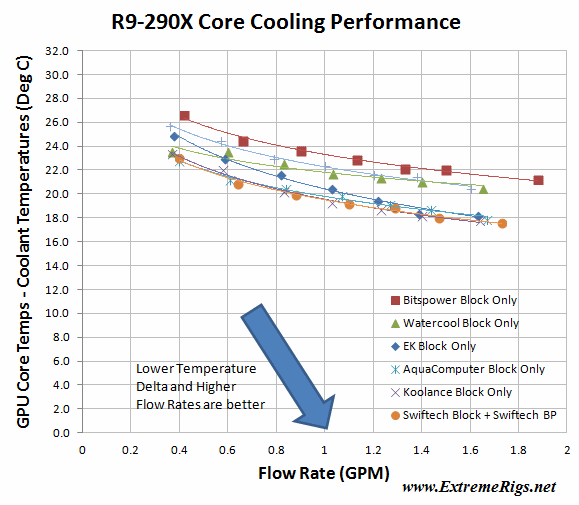

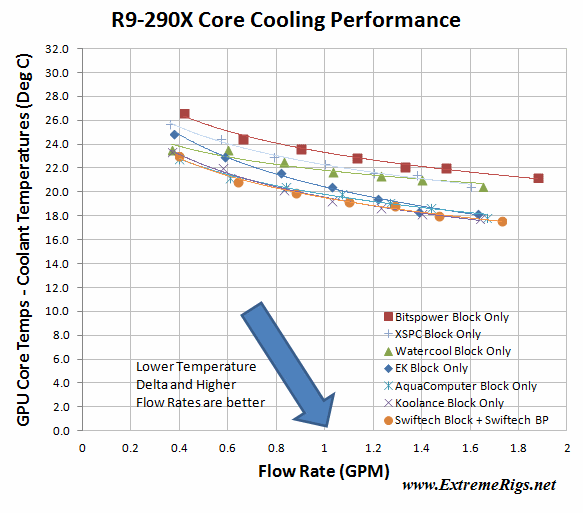

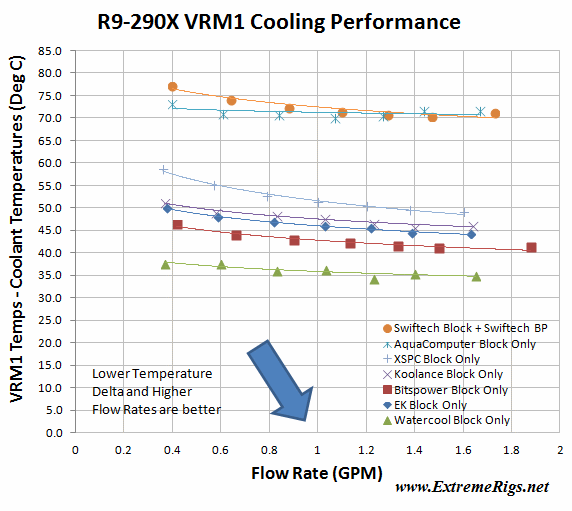
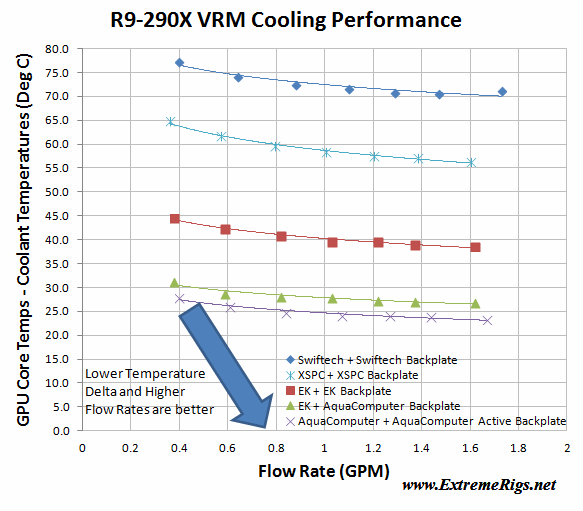
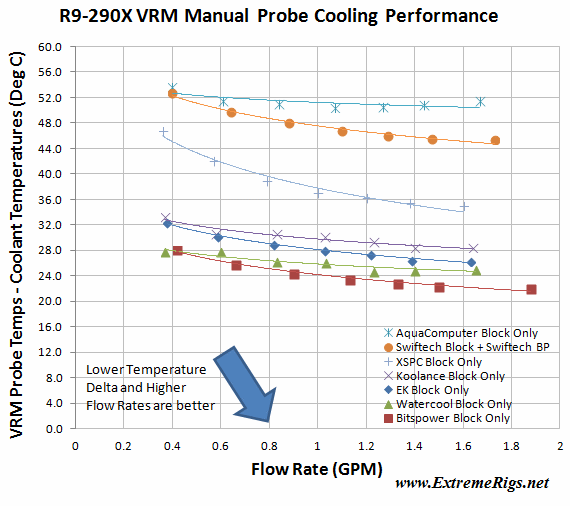

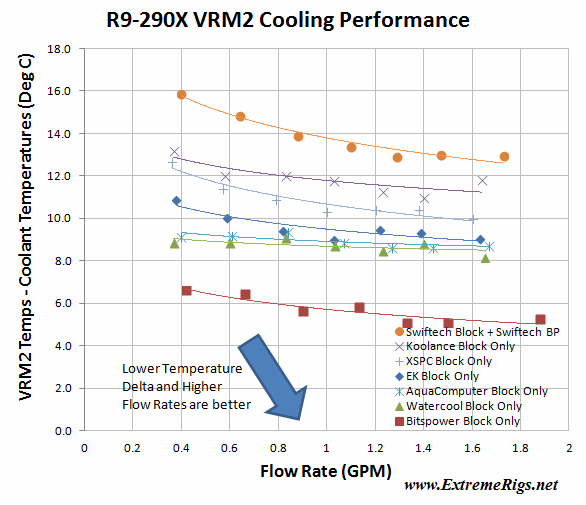





[…] detailed thermal performance check out the detail thermal results page! Here is the […]
Comments are closed.